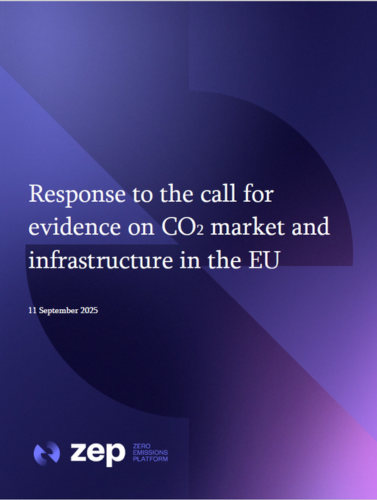Recommendations for CO₂ market and infrastructure in the EU
Zero Emissions Platform (ZEP) responded to the European Commission’s call for evidence on CO2 market and infrastructure in the EU. This framework is essential to safeguard environmental goals and economic welfare as Europe’s industrial carbon management industry begins to scale up. This submission presents 10 recommendations for the forthcoming legislative initiative to ensure the CO2 market enables the necessary infrastructure buildout in line with the European Union’s climate goals.
Key recommendations for CO₂ market and infrastructure
Define the CO2 market appropriately
The forthcoming legislative initiative should recognise CO2 management as a commodity, not as a waste, primarily to avoid unnecessary legal barriers. However, this commodity is fundamentally different than other energy market commodities (e.g., gas and electricity) as it holds no calorific value.
Establish an appropriate legal basis
The CO₂ market and infrastructure regulatory framework should be designed to achieve both economic and environmental objectives, given the importance of industrial carbon management in achieving the EU’s climate goals. Establishing a dual legal basis, rooted in Articles 194 and 192 of the TFEU, is essential to ensure the legislative framework sufficiently caters to both objectives.
Remove legal barriers and expand the legal basis
While the CCS Directive (2009/31 EC) provides a clear framework for licensing storage sites, its implementation varies across Member States. Moreover, barriers exist that inhibit the cross-border transport of CO2 both within the EU and the European Economic Area (EEA), as well as with the UK. Other barriers currently present in the EU Emissions Trading System (ETS) Directive should also be addressed to ensure greater harmonisation within the industrial carbon management policy framework.
Provide clear definitions for ownership models
Various ownership models for CO2 infrastructure and segments in the value chain already exist, with characteristics that could potentially harm economic welfare as the CO2 market grows. Given the nascent state of the market, an approach is needed to ensure the framework both addresses the needs of today and remains adaptive to future developments as liquidity increases.
Develop a clear framework for access and tariffs
Several regulatory approaches towards access and tariff regulation have been advanced at national levels within the EU. Options are available with varying degrees of regulatory oversight as well as ex-ante and ex-post measures. The Commission should consider all available approaches and aim at striking the right balance to enable CO2 infrastructure at the lowest cost.
Enable efficient and resilient network planning
Several options for developing a pan-European industrial carbon management network are available to stakeholders. A legislated approach should carefully weigh the different options while ensuring that the network is built out at an accelerated pace.
